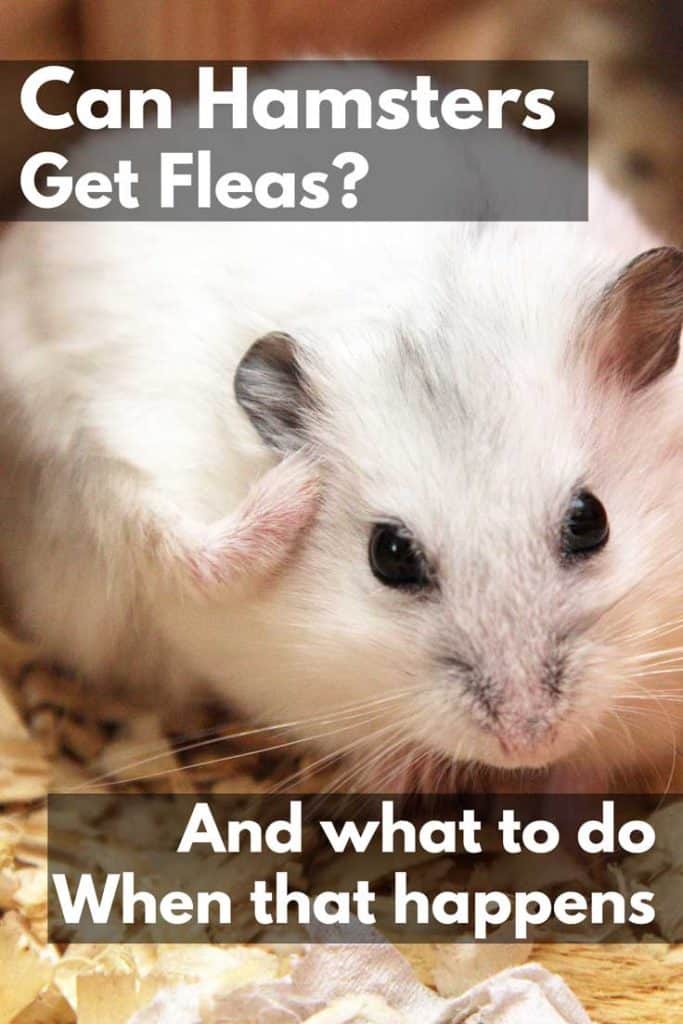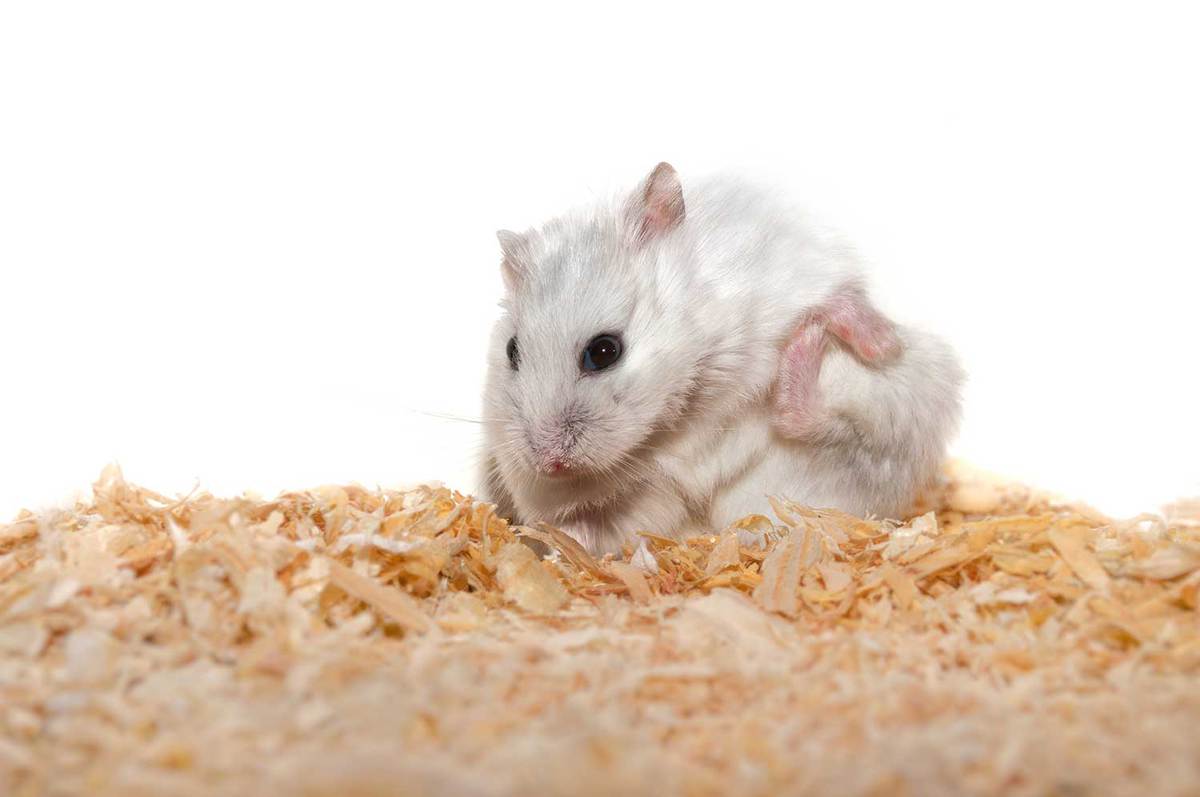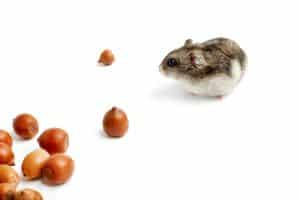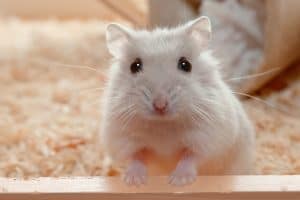Hamsters are strictly indoor animals so the possibility of them getting infested with fleas is something that rarely – if ever – crosses the minds of even the most well-intentioned owners. After all, how can an animal that spends its life inside of a cage, a ball and a home possibly pick up a parasite? We've set out to research this question and bring you solid answers.
 Yes, unfortunately, hamsters are indeed vulnerable to flea infestations. Even if your beloved pet is well-kept and you make sure to keep their living environment as clean as possible, your hamster can still get fleas.
Yes, unfortunately, hamsters are indeed vulnerable to flea infestations. Even if your beloved pet is well-kept and you make sure to keep their living environment as clean as possible, your hamster can still get fleas.
Continue reading to learn how and why hamsters sometimes get fleas. We'll also cover other important aspects of hamster healthcare to help eliminate fleas and reduce the risk of flea infestations in the first place.
Can Hamsters Contract Fleas (And How)
Fleas can thrive and breed on the bodies of all warm-blooded mammals. That makes your hamster vulnerable to becoming a host. Basically, if there's a flea in your household - brought in by another pet or even yourself - it can jump and get settled on your hammy. All it takes is being around another animal that’s been infested.
If your cat or dog has a flea problem, suspected or confirmed, and comes into the area where your hamster lives, that could very well be the source of the hamster’s problem. Fleas will often jump from host to host whenever possible, leaving eggs that will hatch and continue the cycle even once the initial infestation has moved on.
It is also possible for fleas to reside in a hamster’s bedding. Once any fleas are on your hamster and in the cage, there is a great likelihood that there are flea eggs in the bedding.
Fortunately, fleas can be a relatively harmless inconvenience when detected early-on and met with action on the part of the hamster’s owner,
However, many owners mistakenly believe that their indoor hamster can’t get fleas. And that could mean that the problem isn't tackled early on, allowing the fleas time to multiply. That's when you get an actual flea infestation.
All too often these parasites are given the opportunity to grow and thrive on a hamster’s fur and skin. It's not only disgusting. It can also lead to detrimental health problems in a short period of time. In this article, we will cover what to do when you’ve caught a flea infestation, how to prevent fleas in the first place, and how to address the potential causes of your pet’s flea problems.
Signs that Your Hamster May Have Fleas

The telltale calling card of fleas is a persistent itching that will prompt your hamster, or any other animal infested with them, to scratch incessantly at their body.
For many hamster owners, this is the very first indication that there is something wrong. They may see their hamster gnawing at themselves or rubbing their body vigorously against the bars of their cage to alleviate the itching. This behavior can lead to patches of hair loss, if left to persist for too long, and can cause aggravation to the hamster’s skin.
If you are seeing these symptoms suddenly, it is possible that your hamster has fleas or even mites, another parasitic infestation not uncommon in hamsters.
Attentive owners may also physically observe the presence of fleas on their hamster’s body.
Fleas are large enough to be seen with the naked eye, as are the flea droppings that they may leave behind. These droppings are referred to as “flea dirt” most commonly and resemble small, black dots. Fleas look a lot like small, black dots as well, but they can be seen moving without too much effort. Oftentimes, you can even see them jump.
Identifying a Flea Infestation on Your Hamster
To confirm a flea infestation on your hamster’s body, follow these steps:
- Part their fur to get a look at the roots of their fur and the skin beneath it. Especially in long-haired Syrian hamsters, it might be difficult to assess a potential flea situation without this step.
- Check their bedding. If your hamster has fleas, then their environment will also be infested.
- Take a fine-toothed comb to your hamster’s body. Wipe the comb down onto a fresh, white paper towel. If there is, in fact, a flea infestation, you will see fleas or flea dirt on the towel.
- Add a couple of drops of water to the findings on the towel. Fleas feast on the blood of mammals, so you should see some redness appear when the droppings on the towel become wet.
If you are presented with fleas and flea droppings, it is important that you act quickly to eliminate the infestation.
What to do if your hamster gets fleas
Your veterinarian is an important resource when combating flea infestations on any pet that you have.
Your vet should be able to accurately diagnose and prescribe treatment for the condition, which typically entails the killing of existing fleas as well as the eggs that they have laid on your hamster’s body. It doesn’t take long for what seems to be a “minor” infestation to become a big problem, so it’s best to act as promptly as possible and schedule an appointment with the vet.
Your vet will likely prescribe a spray that can be used on your hamster and their environment to kill and prevent fleas in the immediate future. Always check with a veterinarian before using any commercial flea spray on your hamster! Some flea treatment may be ok for dogs or cats but not for hamsters. Your veterinarian will also guide you through dosaging.
In-between the discovery of fleas and your veterinary appointment, you can take several steps to minimize the issue.
- Place the hamster into a clean and dry bin while you empty out their cage. Remove all bedding, toys, food dishes and bottles. Put the bedding into a garbage bag, tie it tight, and throw it away.
- If your hamster has any permeable toys, like ones made out of soft-wood or cardboard, discard them immediately. Wash all hard, plastic toys and accessories in hot water with a mild soap, just like you would when routinely clean your hamster’s cage.
- Wash the cage itself with the same hot water and soap. You don’t want to reintroduce your hamster to their cage before you have deep-cleaned it, as you don’t want to risk making their infestation worse.
- Once the cage is completely 100% dry, you can place in new, fresh bedding. Since hamsters can sometimes contract fleas from improperly stored or improperly packaged bedding, it’s advisable to check the new bedding before you put it in their cage. If you see any sign of fleas in this bedding, buy some brand-new bedding from your local retailer.
- If you have other pets in your home, you will likely need to treat them, too. Fleas move from host to host very quickly, leaving eggs in their wake that allows an infestation to quickly spread. Make sure to treat your other pets by checking their bedding and toys and using flea treatments as recommended by their veterinarian.
- You will also likely have to treat your home to prevent the continuation of the flea reproduction cycle. Vacuum your whole house, especially areas where your pets like to be the most. Wash all bedding. Treat carpeted areas with a solution that’s designed to tackle flea infestation and kill the eggs.
Preventing Fleas on Your Hamster
If you have other pets in your home, it is best that you make sure to be proactive about fleas before anybody becomes a host to these parasites.
Make sure to stay on top of your cat’s, dog’s and other mammalian pets’ flea treatments to prevent infestations in the first place. This is much easier than trying to tackle an ongoing flea infestation among several animals and inside of your home once the infestation has already made itself known. As it is with all other medical concerns for our pets and ourselves, prevention is key to healthfulness.
Keeping your hamster’s environment clean on a routine basis will also help to curb the risk of flea infestation. Fleas can reside in the bedding of your hamster’s enclosure, where they may be left to breed and thrive until you get around to the next deep-cleaning of the cage. Each day, when removing soiled bedding from your hamster’s cage, do a visual check for anything that’s unusual. If fleas are present, it won’t be hard to see them.
Read more: How often should you clean your hamster's cage
Make sure to check your hamster’s bedding before you introduce it to their cage, each and every time. Most of the time, bedding that has been processed and packaged by manufacturers is entirely safe to use. But it never hurts to do a visual inspection and toss any bedding that doesn’t look 100% clean and parasite-free.
Fleas are Easy to Spot but Difficult to Treat
A flea infestation, even on just one hamster, can lead to a cycle of cleaning and frustration for their owners as well as the hamster themselves. If you are spotting fleas on your hamster or in their bedding, it is paramount that you act promptly to address and rectify the problem. To wait, thinking that fleas are no great concern, could lead to an infestation that may take over your whole house and even infest other pets.
Certain factors may contribute further to the development of flea infestations, but let’s face it – it’s not hard for fleas to thrive on any furry mammal. If you’ve ever had a dog or cat with fleas, you know exactly what we mean.
Act quickly, get to your vet and clean house to minimize the growth of the infestation and bring your hamster back to their ideal health and happiness.
Are fleas in hamsters common?
Nope. You're very likely not never see a flea on your hamster, especially if you don't have another pet that goes outside.
Most hamster owners will never have to deal with fleas (yay!) but it's important to know that the possibility is there. If you notice any signs of fleas in your home, make sure to check your hammy and take action quickly.
Flea infestation, in fact, is really unavoidable and it can even found on other pets like dogs and cats. Well, with the information provided above are you convinced enough to take care of your hamster? Check out 37 Hamster Care Tips that will take you to the next level.




great to know